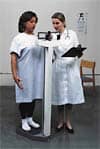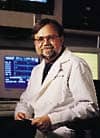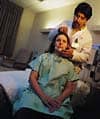Staying Power in South Carolina
The Southeast Regional Sleep Disorders Center-SleepCor remains one step ahead of its competitors by providing quality care for patients who have a variety of sleep disorders.
 Merghan Sokhandan, MD, FCCP, and Freddie E. Wilson, MD, FACP.
Merghan Sokhandan, MD, FCCP, and Freddie E. Wilson, MD, FACP.
Since opening its doors to the public in 1994, Southeast Regional Sleep Disorders Center-SleepCor in Greenville, SC, has not only seen explosive growth, it has also witnessed a dramatic change in the field of sleep medicine. Eight years ago, when Southeast Regional Sleep Disorders Center started treating patients with sleep problems, it was one of the few places in town offering this type of service. Now Southeast Regional is one of many sleep laboratories, although it is the only freestanding sleep disorders center in the Greenville area that is accredited by the American Academy of Sleep Medicine (AASM).
Katrinka Scalise, regional operations manager, stresses that one of the biggest changes during the past several years has been the decreasing age of patients. “There was a time when most of our patients were over the age of 60, but now we’re seeing patients at a younger age so we can prevent other medical conditions that are usually associated with long-term sleep apnea,” Scalise says. Children can also exhibit sleep disorders and are treated regularly at Southeast Regional.
Southeast Regional is part of Atlanta-based SleepCor, which is one of the nation’s largest fully integrated providers of sleep disorders services. SleepCor, which is active in more than 16 states and performs more than 12,000 sleep studies per year, is composed of four divisions: hospital-based sleep laboratories, freestanding sleep laboratories, mobile sleep services, and contract support services. SleepCor, which was started in 1992, is a division of Louisville, Ky-based Kindred Healthcare, a national operator of nursing homes and long-term acute care hospitals.
The primary business of Southeast Regional, as well as SleepCor’s other facilities, is to provide sleep diagnosis and treatment to patients suffering from sleep-related disorders and to make sleep services available to the medical community.
The six-bed Southeast Regional Sleep Disorders Center is housed in a freestanding facility in a business complex located within easy reach of downtown Greenville. According to Scalise, providing convenient locations to patients is particularly important for sleep centers. “Many of our patients have spent a lot of time going from one doctor to another, trying to find a diagnosis for their symptoms and treatment,” she says. “We want to make sure that by the time they call us, it’s easy locating us.” The Greenville facility also has two satellite offices: a freestanding four-bed center in Anderson, SC, and a two-bed sleep laboratory in Easley, SC, which is located in the Palmetto Baptist Hospital. In addition, Southeast Regional has three fee-for-service contracts with other hospitals as well as a scoring center, which scores tests for 10 hospitals and supplies them with equipment. Plans are also under way to open another satellite facility within a 30-mile radius of Greenville in 2003.
To ensure the greatest comfort for patients, each of the bedrooms at Southeast Regional is a spacious 12 x 14 feet, and contains comfortable queen-sized beds, a television set, and other amenities. A large reception area is also available for patients’ comfort. A roomy 12 x 16 foot kitchen is also accessible for the patients to use. “Since we do daytime studies, many of our patients like to have lunch here,” Scalise says. The facility is located near a quiet, wooded area where many patients undergoing daytime studies enjoy taking a walk. There is a relatively strong demand for daytime sleep studies in Greenville because of the many corporations, such as Michelin and BMW, which have large numbers of third-shift workers in the area. As an added convenience, sleep studies are also offered to patients on the weekends.
Southeast Regional has 25 staff members and 15 of them are sleep technicians. The staff is cross-trained and works not only at the Greenville facility, but also at the satellite locations in Anderson and Easley. The nighttime technicians work from 9 pm to 7 am, 4 days a week, and the daytime technicians tend to work from 7 am to 4 pm. Like most sleep centers, Southeast Regional finds that one of its biggest challenges is keeping third-shift employees. “Third shift is usually difficult because you can run into communication problems between the day and night shifts and many employees just find it difficult working nights,” Scalise says. “Still, many people are attracted to our center because we offer our staff not only strong benefits, but also the chance to work in an accredited laboratory with physicians who have strong reputations in sleep medicine.”
 Freddie E. Wilson, MD, FACP, assists Kimi Clark, RPSGT, in reviewing a sleep study in the technicians’ room.
Freddie E. Wilson, MD, FACP, assists Kimi Clark, RPSGT, in reviewing a sleep study in the technicians’ room.
Going the Extra Mile
Another feature that distinguishes Southeast Regional from other sleep laboratories in the Greenville area is the medical leadership by two board-certified sleep specialists. Freddie E. Wilson, MD, FACP, is the center’s medical director. Wilson has more than 25 years of experience in sleep medicine and is board-certified in pulmonary and internal medicine. Merghan Sokhandan, MD, FCCP, has worked with the center for 6 years and in addition to her certification in sleep medicine, she is board-certified in pulmonology, internal medicine, and critical care. Wilson and Sokhandan see each patient either before or immediately following a sleep study. “Physicians even travel to the satellite locations to follow up with patients,” Scalise says. Many of Southeast Regional’s sleep technicians are attracted to the center because of their working relationship with Wilson and Sokhandan. Some are directly involved in assisting the physicians with studies that are submitted to national meetings or journals.
During the past several years, the type of patients Southeast Regional has treated has changed dramatically. In addition to a decrease in the average age of patients and the increased number of female patients seen in the center, the payor mix has gone through changes since 1994. Scalise attributes this to an overall increase in the awareness of sleep disorders.
In addition to the Medicare/Medicaid population, the center also has a few contracts with managed care companies and has some workers’ compensation cases, primarily involving truck drivers. “We would like to work more with truckers, but many of their health plans exclude the treatment of sleep disorders,” Scalise says. “This could be because most trucking companies do not want records kept on any sleep problems their employees may have.”
Marketing Efforts
If private pay represents the bulk of Southeast Regional’s business, how does it publicize its services to potential patients, particularly when it serves such a large geographical market? Although Southeast Regional recently hired a marketing associate to handle promotion and occasional advertising, it has relied more heavily on physician networking and community outreach. The marketing associate meets regularly with physicians in the area to bring them up to date on new programs offered by the center. Most physicians appreciate the fact that Southeast Regional is an accredited laboratory; however, Scalise points out that physician education is an ongoing process since some physicians are attracted to new services offered by other sleep laboratories in the area. “The physicians are unaware that some sleep labs do not provide the same level of service,” she says. “All we can do is keep providing the same high level of quality care, and we end up eventually gaining back most of these physicians’ patients.”
 Freddie E. Wilson, MD, FACP, and Kimi Clark, RPSGT, discuss how to adjust a CPAP mask.
Freddie E. Wilson, MD, FACP, and Kimi Clark, RPSGT, discuss how to adjust a CPAP mask.
Southeast Regional has also been successful in its community outreach marketing efforts. The center is usually directly involved in local companies’ employee health fairs and has even sent its technologists to church-sponsored group meetings. During Sleep Awareness Week, sponsored by the National Sleep Foundation, Southeast Regional always conducts two or three different activities. This year, it worked with a national mattress manufacturer in hosting a blood drive at the center. This gave everyone an opportunity to learn more about Southeast Regional’s services. Public service announcements discussing problems associated with snoring were aired on the local radio stations throughout the week. “We get a tremendous amount of business directly from these types of community events,” Scalise says.
Obstructive Sleep Apnea
Like most sleep centers, Southeast Regional treats primarily patients who are diagnosed with obstructive sleep apnea (OSA). Government statistics reveal that 80% of individuals exhibiting some form of sleep-related disorder will be diagnosed with OSA symptoms as their primary underlying diagnosis. The most common treatment for OSA is continuous positive airway pressure (CPAP), which provides a flow of positive pressure air through a nasal mask to keep the airway open during sleep. While using CPAP, breathing becomes regular, snoring stops, and the patient is able to achieve restful sleep. “Most patients respond favorably to CPAP,” Wilson says.
A support group held quarterly for patients with OSA has been well received by patients of Southeast Regional and its satellite facilities. “By meeting with other patients who have OSA, they learn that they’re not alone with this condition and they share information on how to cope with it,” Scalise says, who points out that the group has grown from eight to more than 75 members. Some of the regular members of the support group even bring in friends or relatives who they think may be experiencing OSA. Physicians and durable medical equipment (DME) representatives are featured speakers at these meetings.
Plans are also under way to launch a CPAP clinic in conjunction with the support group. The clinic would be offered during the day for patients on CPAP. “This would be a great service to our patients, since they frequently have questions and are unable to reach someone from the DME company who can answer their questions,” Scalise says. “Our technicians would be available during these clinics to address concerns the patients may be having.”
 Kimi Clark, RPSGT, adjusts a patient’s CPAP mask.
Kimi Clark, RPSGT, adjusts a patient’s CPAP mask.
Although OSA is the most common sleep disorder, Wilson notes that other disorders may be diagnosed when completing diagnostic sleep studies. Wilson cites that restless legs syndrome (RLS) is the most under-recognized sleep disorder. It has been found that between 5% and 10% of the population is thought to be affected by this condition, which is characterized by intense restlessness, particularly at night. Patients with this disorder find themselves repeating the same motion in periodic bursts, most notably flexing the entire leg while extending the toes. “One of the big problems with restless legs is that patients often have difficulty describing the symptoms,” Wilson says. The primary treatment for people with RLS is medication that affects dopamine levels, as well as muscle relaxants and sleeping pills. Related to RLS is periodic limb movement disorder, which is a jerky movement of a limb or limbs at regular intervals.
Looking Ahead
Wilson is also in the process of putting together a therapy clinic for patients experiencing problems with insomnia. Patterned after a program offered at Duke University, the clinic would offer patients the opportunity to meet regularly with sleep specialists and a psychologist to help prevent insomnia. More than 35 million Americans complain of suffering from insomnia.
Scalise points out that having the financial backing from a large company like Kindred means it is able to offer a full range of comprehensive services to the public. For example, the acquisition of information technology has been relatively easy because of the support from Kindred’s Information Systems Department. Southeast Regional has invested considerable resources in upgrading its servers and circuit lines and has also recently moved its computer programs—involving everything from scheduling to patient histories—to the national office. “We’re hoping to start archiving our sleep studies at our parent company’s headquarters, so they can always be easily retrieved electronically by physicians,” Scalise says. Southeast Regional has also been able to utilize Kindred’s marketing department to assist the center in producing printed materials for marketing campaigns.
As competition has increased, Southeast Regional has taken extra steps to ensure that patient satisfaction is always maintained. Patients fill out surveys after their studies and a physician always reviews the surveys. The physician also takes time out in a follow-up visit to ask about the patient’s experience. “Sometimes patients feel uncomfortable filling something out on the form, especially if they have a comment to make about a specific technician, so we’ve found that it works best if the physician also asks them about their study,” Scalise says. A suggestion box is also available for patients to submit comments privately.
With five major sleep laboratories open in the Greenville area, Southeast Regional works in a completely different environment than it did 9 years ago; however, since many of these laboratories are not accredited by the AASM, Scalise stresses that keeping its focus on meeting the AASM standards will ensure that Southeast Regional remains successful. “Other sleep labs will advertise that they are accredited, but that’s because they might be accredited by JCAHO (Joint Commission on Accreditation of Healthcare Organizations) or another organization,” she says. “Since many of these labs don’t offer comprehensive services and don’t follow up with their patients after the studies, many of these same patients in the end come to us for what we have to offer—high-quality services complete with patient follow-up.”
Carol Daus is a contributing writer for Sleep Review.




